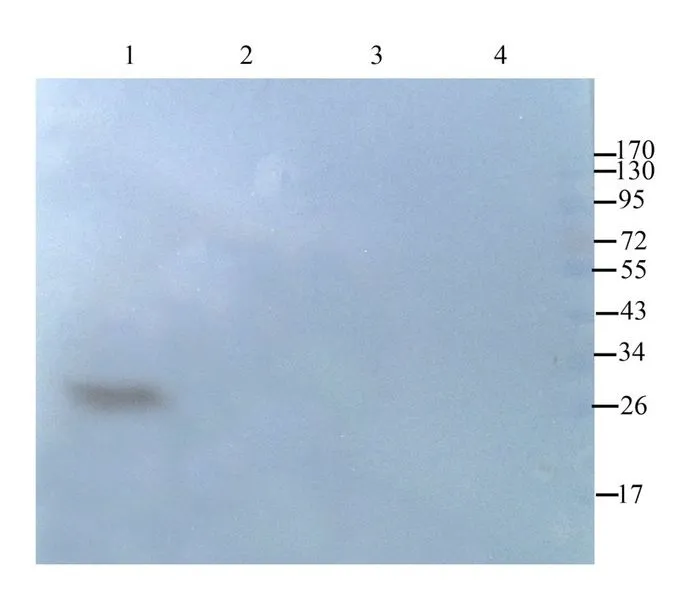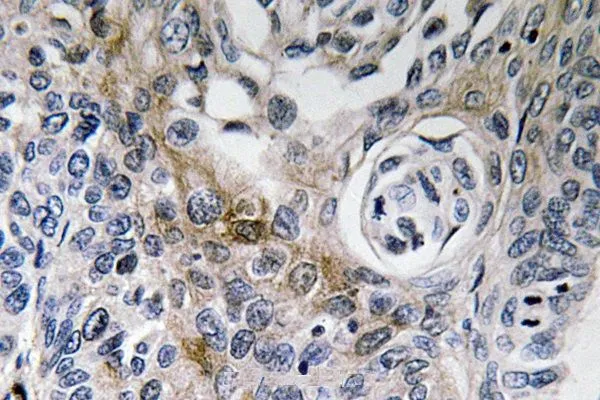
IHC-P analysis of mouse lymph node tissue using GTX37555 CD63 antibody. Dilution : 2.5microg/ml
CD63 antibody
GTX37555
ApplicationsWestern Blot, ImmunoHistoChemistry, ImmunoHistoChemistry Paraffin
Product group Antibodies
TargetCD63
Overview
- SupplierGeneTex
- Product NameCD63 antibody
- Delivery Days Customer9
- Application Supplier NoteWB: 1:100-1000. IHC-P: 1:100-500 (based on 0.5 mg/ml). *Optimal dilutions/concentrations should be determined by the researcher.Not tested in other applications.
- ApplicationsWestern Blot, ImmunoHistoChemistry, ImmunoHistoChemistry Paraffin
- CertificationResearch Use Only
- ClonalityPolyclonal
- Concentration0.5 mg/ml
- ConjugateUnconjugated
- Gene ID967
- Target nameCD63
- Target descriptionCD63 molecule
- Target synonymsAD1, HOP-26, ME491, MLA1, OMA81H, Pltgp40, TSPAN30, CD63 antigen, AD1 antigen, CD63 antigen (melanoma 1 antigen), granulophysin, limp1, melanoma-associated antigen ME491, melanoma-associated antigen MLA1, ocular melanoma-associated antigen, tetraspanin-30, tspan-30
- HostRabbit
- IsotypeIgG
- Protein IDP08962
- Protein NameCD63 antigen
- Scientific DescriptionThe protein encoded by this gene is a member of the transmembrane 4 superfamily, also known as the tetraspanin family. Most of these members are cell-surface proteins that are characterized by the presence of four hydrophobic domains. The proteins mediate signal transduction events that play a role in the regulation of cell development, activation, growth and motility. The encoded protein is a cell surface glycoprotein that is known to complex with integrins. It may function as a blood platelet activation marker. Deficiency of this protein is associated with Hermansky-Pudlak syndrome. Also this gene has been associated with tumor progression. Alternative splicing results in multiple transcript variants encoding different protein isoforms. [provided by RefSeq, Apr 2012]
- Storage Instruction-20°C or -80°C,2°C to 8°C
- UNSPSC12352203
References
- Exosomal miR-27b-3p Derived from Hypoxic Cardiac Microvascular Endothelial Cells Alleviates Rat Myocardial Ischemia/Reperfusion Injury through Inhibiting Oxidative Stress-Induced Pyroptosis via Foxo1/GSDMD Signaling.Read more
- Human induced pluripotent stem cell-derived extracellular vesicles reduce hepatic stellate cell activation and liver fibrosis. Povero D et al., 2019 Jun 11, JCI InsightRead more
- MiR-21 in extracellular vesicles contributes to the growth of fertilized eggs and embryo development in mice. Lv C et al., 2018 Aug 31, Biosci RepRead more
- Large-scale isolation and cytotoxicity of extracellular vesicles derived from activated human natural killer cells. Jong AY et al., 2017, J Extracell VesiclesRead more
- Circulating microRNAs, miR-939, miR-595, miR-519d and miR-494, Identify Cirrhotic Patients with HCC. Fornari F et al., 2015, PLoS OneRead more








![FACS analysis of peripheral blood lymphocytes from a patient with allergy to bee venom after stimulation with bee venom using GTX18235 CD63 antibody [MEM-259] (FITC).](https://www.genetex.com/upload/website/prouct_img/normal/GTX18235/GTX18235_20191025_AP_006_134_w_23060620_554.webp)
![FACS analysis of IgE-activated peripheral blood using GTX18236 CD63 antibody [MEM-259] (PE).](https://www.genetex.com/upload/website/prouct_img/normal/GTX18236/GTX18236_20191025_AP_006_135_w_23060620_482.webp)
![IHC-P analysis of human melanoma tissue using GTX21318 CD63 antibody [NK1/C3NKI/C3 (MX-49.129.5)].](https://www.genetex.com/upload/website/prouct_img/normal/GTX21318/GTX21318_20191203_IHC-P_82_w_23060620_402.webp)